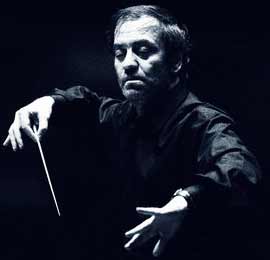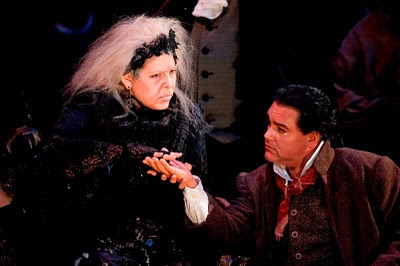Fall is here, and now that most of the season openers and galas are almost finished, the classical music season will soon be under way in earnest. Many good things are on the schedule (follow our calendar for a complete listing), far too many to feature here: what follows is the events that should be marked in red on your calendar for the rest of the year.
SYMPHONY:
 Washington Performing Arts Society continues its tradition of bringing the best visiting orchestras to Washington, beginning with the Mariinsky Orchestra (October 19), with Valery Gergiev leading a cast of thousands (really, hundreds) in Mahler's eighth symphony at the Kennedy Center Concert Hall. (The work was last heard in Washington in 2006.) Next up is a conductor we have been wanting to see live, Daniel Harding, leading the Dresdner Staatskapelle (November 3), in a program of Schumann and Brahms, including pianist Rudolf Buchbinder in the former's piano concerto. That will take precedence in our book over the Academy of St. Martin in the Fields, led by pianist Jonathan Biss the same evening at Strathmore, but others may disagree. Strathmore also hosts the Moscow Virtuosi Chamber Orchestra (November 19) in a program that remedies the only deficit noted of their 2008 performance -- some Schnittke to go with the Shostakovich.
Washington Performing Arts Society continues its tradition of bringing the best visiting orchestras to Washington, beginning with the Mariinsky Orchestra (October 19), with Valery Gergiev leading a cast of thousands (really, hundreds) in Mahler's eighth symphony at the Kennedy Center Concert Hall. (The work was last heard in Washington in 2006.) Next up is a conductor we have been wanting to see live, Daniel Harding, leading the Dresdner Staatskapelle (November 3), in a program of Schumann and Brahms, including pianist Rudolf Buchbinder in the former's piano concerto. That will take precedence in our book over the Academy of St. Martin in the Fields, led by pianist Jonathan Biss the same evening at Strathmore, but others may disagree. Strathmore also hosts the Moscow Virtuosi Chamber Orchestra (November 19) in a program that remedies the only deficit noted of their 2008 performance -- some Schnittke to go with the Shostakovich.
After a couple of seasons with programming that outdid her neighbors to the south, Marin Alsop's Baltimore Symphony takes a backseat this fall to the first season programmed by Christoph Eschenbach. The National Symphony Orchestra's season opens with three must-hear programs, including the pairing of Pintscher's Hérodiade-Fragmente and Beethoven's ninth symphony (September 30 to October 2), Christian Tetzlaff playing Beethoven's violin concerto, paired with Bruckner's sixth symphony (October 7 to 9), and an all-Mahler program with the fifth symphony and contralto Nathalie Stutzmann singing the Kindertotenlieder (October 14 to 16). We will want to see guest conductors Susanna Mälkki (November 18 to 20) and Emmanuel Krivine (December 2 to 4), although the music on offer is less interesting. To end the year we do have high hopes for Rinaldo Alessandrini, who will lead this year's performance of Handel's Messiah.
As for worthwhile programs in Baltimore, there is more Mahler to celebrate with Marin Alsop's take on the seventh symphony, paired with Mahler's adaptation of a Bach suite (September 24 and 25). We are also inclined to hear Stefan Jackiw play Mendelssohn's violin concerto, paired with another performance of John Adams's Doctor Atomic Symphony (September 30, October 2 and 3). However, it is not really until much later in the season that we get to something really tantalizing, the return of guest conductor Günther Herbig, leading Shostakovich's tenth symphony (November 20 and 21), with violinist Tianwa Yang in Prokofiev's first violin concerto.
VOCAL AND OPERA:
 Singers that make the cut include the countertenor Yuri Minenko (October 7), presented by Vocal Arts D.C. in the Kennedy Center Terrace Theater. Other Vocal Arts performances on our calendar include New York Festival of Song (October 24), with mezzo-soprano Sasha Cooke and tenor Paul Appleby, and mezzo-soprano Alice Coote (November 4), who will also be appearing with the English Concert at the Library of Congress (October 14). Other noteworthy recitals are a Dichterliebe sung by tenor Christoph Genz (October 20) at the Clarice Smith Center -- an unusual version with legendary musicologist and pianist Charles Rosen at the piano. Rosen will also give a lecture (October 21) as part of the University of Maryland's Schumann Festival the following day. The Library of Congress will also present baritone Thomas Hampson and pianist Craig Rutenberg for a free recital (October 28).
Singers that make the cut include the countertenor Yuri Minenko (October 7), presented by Vocal Arts D.C. in the Kennedy Center Terrace Theater. Other Vocal Arts performances on our calendar include New York Festival of Song (October 24), with mezzo-soprano Sasha Cooke and tenor Paul Appleby, and mezzo-soprano Alice Coote (November 4), who will also be appearing with the English Concert at the Library of Congress (October 14). Other noteworthy recitals are a Dichterliebe sung by tenor Christoph Genz (October 20) at the Clarice Smith Center -- an unusual version with legendary musicologist and pianist Charles Rosen at the piano. Rosen will also give a lecture (October 21) as part of the University of Maryland's Schumann Festival the following day. The Library of Congress will also present baritone Thomas Hampson and pianist Craig Rutenberg for a free recital (October 28).
As for opera performances, the field is thinning out, and it remains to be seen if the smaller local companies can pick up the slack. From Washington National Opera the highlight is surely Richard Strauss's Salome, with Deborah Voigt making her company debut in a celebrated role (October 7 to 23). We would add to the short list Cilea's Adriana Lecouvreur, performed by Washington Concert Opera (October 24), which will feature two lovely singers in soprano Mary Elizabeth Williams and mezzo-soprano Elizabeth Bishop.
CHAMBER MUSIC:
Washingtonians are lucky to have the chance to hear many fine string quartets each season, but we will single out the free concert by the Arcanto Quartet, a group including cellist Jean-Guihen Queyras and violist Tabea Zimmermann, at the Library of Congress (October 13). Also at the top of our list are the Talich Quartet in two concerts, at the Library of Congress (October 21) and with the Candlelight Concert Society in Columbia, Md. (October 23), and the Tokyo Quartet with pianist Jeremy Denk, hosted by WPAS at Strathmore (November 21). Other chamber music concerts we highly recommend are a recital by Stefan Jackiw at the Jewish Community Center of Greater Washington in Rockville (October 17), cellist Gautier Capuçon and pianist Gabriela Montero at the Library of Congress (November 9) and again at Shriver Hall in Baltimore (November 14).
PIANO:

Pianist Till Fellner (photo by Francesco Carrozzini) |
For your keyboard pleasure, we recommend the free concert by Håkon Austbø at the National Gallery of Art (October 6); the ultimate conclusion, deferred by snow, of Till Fellner's spectacular Beethoven sonata cycle, at the Austrian Embassy (October 17); as well as the WPAS-sponsored recitals by András Schiff (October 20) and Emanuel Ax (November 10), both at Strathmore.
CONTEMPORARY:
For music by living composers, there will be another local appearance by the Bang on a Can All-Stars, in an all-Steve Reich program at Strathmore (November 11). We also really look forward to the free concert of music by Louis Andriessen presented by the Great Noise Ensemble at the National Gallery of Art (October 24). Not all of the programs on the docket from the innovative Mobtown Modern series, in Baltimore, are quite our cup of tea, but one will never be disappointed there by routine programming.
EARLY MUSIC:
In our favorite specialty, historically informed performance practice, there are many good things to recommend, starting with the always rewarding Noontime Cantata Series, presented by members of the Washington Bach Consort at the Church of the Epiphany (October 5, November 2, December 7), free concerts convenient for those who take their lunch downtown. We also look forward to some concerts by violinist and Georgia native Robert McDuffie: a solo recital at the Phillips Collection (October 3) -- nota bene, this concert series is no longer free -- and an appearance at the head of the extraordinary Venice Baroque Orchestra, in a program of music by Vivaldi and Glass, at Strathmore (November 14). Another superb violinist, Rachel Podger, headlines the concert by the English Concert, with mezzo-soprano Alice Coote, at the Library of Congress (October 14). Local favorite Opera Lafayette presents a rarity, Clérambault's La Muse de l'Opéra, with soprano Judith van Wanroij, at the Kennedy Center Terrace Theater (November 15). Finally, the vocal quartet Anonymous 4 returns to Washington for a concert also at the Terrace Theater (December 16).



















































































